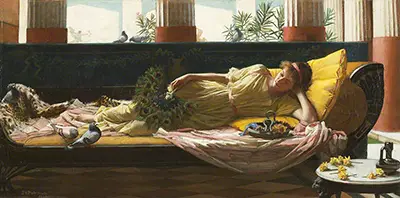The painting is both realistic in conception, yet the woman seems otherworldly, as if the scene is taking place in a time from long ago. The title of Dolce far Niente translates from the original Italian to mean 'the sweetness of doing nothing', and John William Waterhouse effortlessly captures the feeling of whiling away the hours by enjoying simple, solitary pleasures. Dolce far Niente by John William Waterhouse uses rich and warm colours, with the young woman dressed in a jewel-toned teal dress and a dark night-blue blanket. The rugs beneath her are equally rich and deep in colour, as well as the yellow of the sunflower next to her and the lush green of the scene outside, which is just visible behind a floral curtain. These touches all help to add greater depth and texture to the painting.
John William Waterhouse was part of a painting movement known as the Aesthetic, and Dolce far Niente is a great example of how the artist chose to focus solely on the aesthetics of the scene, with no clear narrative in play. Instead, the detail and depth of the painting is in all the smaller touches, such as the realistic white fathers of the fan, the intricate embroidery on the rugs and curtain, as well as the vein-like detailing on the marble wall. John William Waterhouse was also painting at the same time as the Pre-Raphaelite movement, with Italy providing a great source of artistic inspiration. The style of clothing worn in Italy, coupled with the warm climate and references to antiquity, were beloved by the Pre-Raphaelites and John William Waterhouse also fully embraced the spirit of capturing a single moment in art that this movement had so inspired.
Dolce far Niente by John William Waterhouse also makes use of the 'truth in nature' Pre-Raphaelite love for symbolism. Here he uses a sunflower to represent self-love, blooming beside the young woman in a blue vase as she blooms herself in her blue dress. John William Waterhouse also adds modern touches too, embracing textured brushstrokes to give the scene added realism despite its antiquated setting. John William Waterhouse originally exhibited the painting himself, and it can currently be seen on display in the Kirkcaldy Museum and Art Gallery. Aside from this artist, you might also like the work of Alphonse Mucha who also produced hundreds of female portraits across his career. Highlights from his oeuvre include the likes of F. Champenois France, Four Seasons and Fall.

